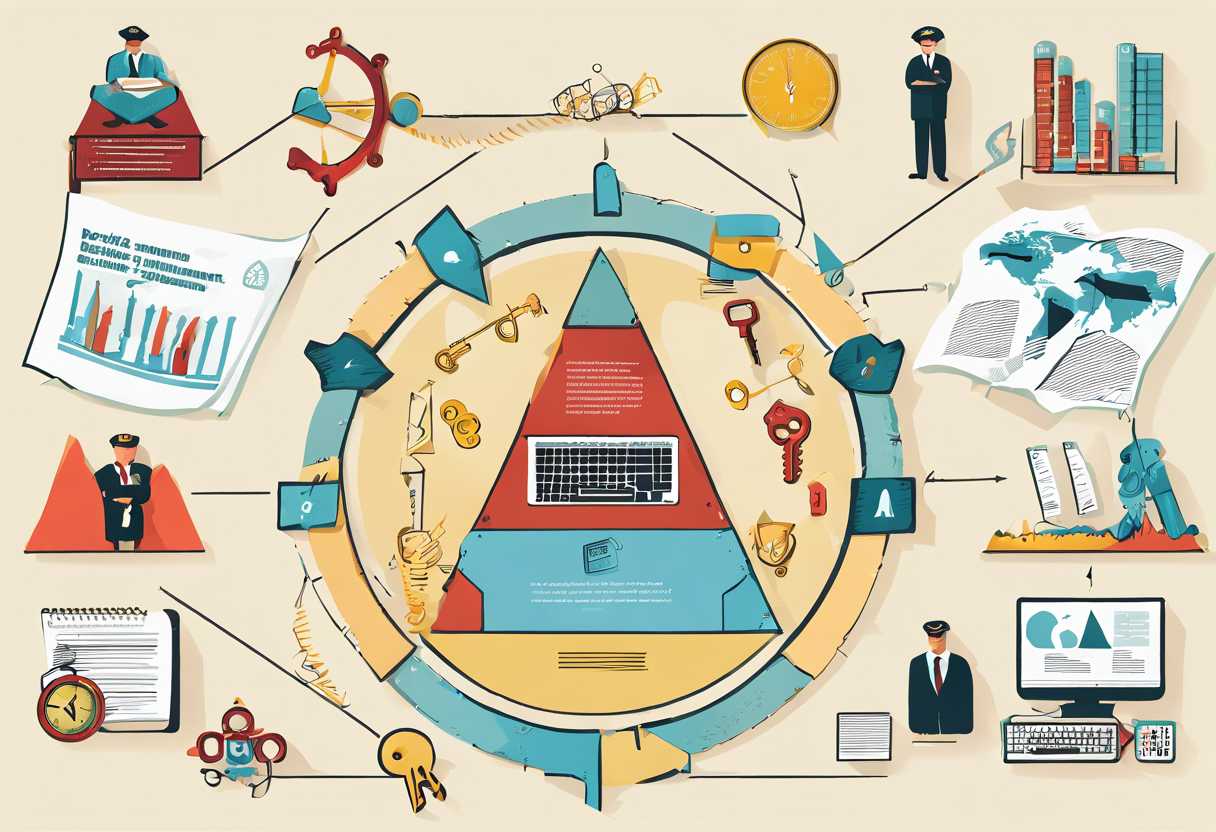Risk management is a crucial aspect of any business operation, ensuring that potential risks are identified, assessed, and mitigated to protect the organization’s assets and reputation. In this blog post, we will delve into the basics of risk management, its importance in business, key components of an effective risk management strategy, common challenges in implementation, and the future trends and innovations in risk management. Whether you are a business owner, manager, or aspiring professional, understanding risk management is essential for safeguarding your organization’s success. So, let’s explore the world of risk management and its impact on the business landscape.
Understanding the Basics of Risk Management
The Importance of Risk Management
Risk management is a crucial aspect of any business or organization. It involves identifying, assessing, and prioritizing risks, and then taking steps to minimize, monitor, and control the impact of these risks. By effectively managing risks, businesses can protect their assets, reputation, and financial stability.
Key Components of Risk Management
There are several key components of risk management, including risk identification, risk assessment, risk mitigation, and risk monitoring. Risk identification involves identifying potential risks that could impact the organization. Risk assessment involves evaluating the likelihood and impact of these risks. Risk mitigation involves taking steps to reduce the likelihood or impact of risks, while risk monitoring involves continuously monitoring and reviewing risks to ensure they are effectively managed.
Common Risk Management Strategies
There are several common risk management strategies that businesses can implement to effectively manage risks. These include risk avoidance, risk reduction, risk transfer, and risk acceptance. Risk avoidance involves avoiding activities that could lead to potential risks. Risk reduction involves taking steps to reduce the likelihood or impact of risks. Risk transfer involves transferring the risk to another party, such as through insurance. Risk acceptance involves accepting the potential impact of a risk and preparing to deal with it if it occurs.

The Importance of Risk Management in Business
Identifying Potential Risks
Risk management is a crucial aspect of running a successful business. One of the first steps in effective risk management is identifying potential risks that could impact the business. This includes assessing internal and external factors that could pose a threat, such as financial risks, operational risks, and market risks. By understanding these potential risks, businesses can develop strategies to mitigate them and protect their operations.
Minimizing Financial Losses
Implementing a robust risk management strategy can help businesses minimize financial losses. By identifying and addressing potential risks, companies can avoid costly disruptions to their operations. This can include having insurance coverage for potential liabilities, diversifying investments to spread risk, and creating contingency plans for unforeseen events. By taking proactive measures to minimize financial risks, businesses can protect their bottom line and ensure long-term sustainability.
Enhancing Decision-Making
Effective risk management can also enhance decision-making within a business. By having a clear understanding of potential risks, business leaders can make informed decisions that take into account potential consequences. This can lead to more strategic and calculated choices that align with the overall goals of the business. Additionally, having a risk management framework in place can provide a sense of security and confidence for stakeholders, including investors, employees, and customers.

Key Components of an Effective Risk Management Strategy
Comprehensive Risk Assessment
An effective risk management strategy begins with a comprehensive risk assessment. This involves identifying, analyzing, and evaluating potential risks that could impact the organization’s objectives. By conducting a thorough risk assessment, businesses can gain a clear understanding of the potential threats they face and develop strategies to mitigate them.
Clear Risk Management Policies and Procedures
Clear and well-defined risk management policies and procedures are essential for effectively managing risks. These policies should outline the organization’s approach to risk management, including risk tolerance levels, risk mitigation strategies, and the roles and responsibilities of key stakeholders. By establishing clear policies and procedures, businesses can ensure that everyone is aligned in their approach to managing risks.
Regular Monitoring and Review
Regular monitoring and review of the risk management strategy is crucial for its effectiveness. This involves continuously monitoring the identified risks, assessing the effectiveness of risk mitigation measures, and making adjustments as necessary. By regularly reviewing the risk management strategy, businesses can adapt to changing circumstances and ensure that their approach to risk management remains relevant and effective.
Common Challenges in Implementing Risk Management
Lack of Clear Understanding of Risks
One of the most common challenges in implementing risk management is the lack of a clear understanding of the risks involved. Many organizations struggle to identify and assess potential risks, which can lead to ineffective risk management strategies. It is crucial for businesses to invest time and resources into understanding the specific risks that could impact their operations, and to develop a comprehensive risk management plan accordingly.
Resistance to Change
Another challenge in implementing risk management is resistance to change within the organization. Employees and stakeholders may be hesitant to adopt new risk management processes and procedures, especially if they have been accustomed to a certain way of doing things for a long time. It is important for businesses to communicate the benefits of risk management and to provide adequate training and support to help employees adapt to the changes.
Inadequate Resources and Tools
Many organizations struggle with implementing risk management due to inadequate resources and tools. Without the right resources, such as skilled personnel, technology, and data analytics tools, it can be difficult to effectively identify, assess, and mitigate risks. Businesses should invest in the necessary resources and tools to support their risk management efforts, and consider outsourcing certain aspects of risk management if internal resources are limited.
The Future of Risk Management: Trends and Innovations
Technology Integration in Risk Management
One of the most significant trends in risk management is the integration of technology. With the rise of big data and artificial intelligence, companies are now able to analyze and predict risks more accurately than ever before. This allows for proactive risk management strategies, rather than reactive ones. Additionally, technology has enabled the automation of many risk management processes, saving time and resources for organizations.
Focus on Cybersecurity Risks
In today’s digital age, cybersecurity risks have become a top concern for businesses. As a result, the future of risk management will see a heightened focus on cybersecurity. This includes implementing robust cybersecurity measures, conducting regular risk assessments, and staying updated on the latest cyber threats. Organizations will need to invest in advanced cybersecurity tools and technologies to protect their sensitive data from potential breaches.
Embracing ESG (Environmental, Social, and Governance) Risks
Another emerging trend in risk management is the increasing emphasis on ESG risks. Companies are now expected to consider the environmental and social impact of their operations, as well as their governance practices. This means that risk management strategies will need to incorporate ESG factors into their assessments and decision-making processes. Organizations that fail to address ESG risks may face reputational damage and regulatory scrutiny.
Conclusion
In conclusion, risk management is a crucial aspect of any business operation, as it helps in identifying, assessing, and mitigating potential risks that could impact the organization’s objectives. By understanding the basics of risk management and recognizing its importance in business, companies can develop effective strategies to manage and minimize potential threats.
Key components of an effective risk management strategy include risk identification, risk assessment, risk mitigation, and risk monitoring. However, implementing risk management can pose challenges, such as resistance to change, lack of resources, and inadequate risk culture. Overcoming these obstacles is essential for the successful implementation of risk management.
Looking ahead, the future of risk management is marked by trends and innovations, such as the use of advanced technology, data analytics, and artificial intelligence to enhance risk assessment and decision-making processes. Embracing these advancements will enable businesses to stay ahead of potential risks and adapt to the evolving landscape of risk management.
As businesses continue to navigate through uncertainties and complexities, it is imperative to prioritize risk management as a fundamental part of their operations. By staying informed about the latest trends and best practices in risk management, organizations can proactively address potential threats and seize opportunities for growth and success.
For more insights on risk management and how it can benefit your business, feel free to reach out to our team of experts. Together, we can help you develop a robust risk management strategy tailored to your specific needs and objectives.

